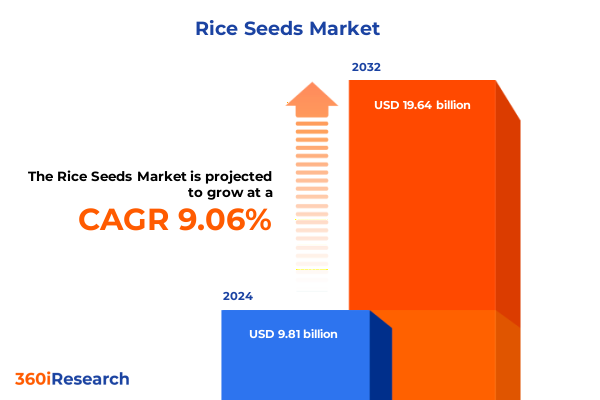The Rice Seeds Market size was estimated at USD 9.81 billion in 2024 and expected to reach USD 10.72 billion in 2025, at a CAGR of 9.06% to reach USD 19.64 billion by 2032.

Navigating the Rice Seeds Market Landscape: Understanding the Critical Role of Seeds in Ensuring Food Security, Technological Advances and Sustainable Production
Rice remains one of the world’s most vital staple crops, nourishing billions and driving economies across continents. In the United States alone, rice production is forecast at 6.96 million metric tons for 2025/26, supported by record imports that push total supplies to 313.5 million hundredweight, illustrating the crop’s prominence in domestic agriculture and trade balances. Globally, production and consumption levels are nearly equal at 538.7 million metric tons, underscoring the delicate equilibrium between supply and demand and the critical importance of seed quality and availability for sustaining food security.
Exploring Transformative Shifts Reshaping Rice Seed Development Through Precision Breeding, Gene Editing Breakthroughs and Climate-Smart Hybrid Varieties Driving Market Evolution
The rice seeds sector is experiencing a seismic shift driven by advances in climate-smart breeding. In June 2023, the Food and Agriculture Organization launched WDR-73, a water-saving and drought-resistant rice variety developed under the FAO-China-Uganda South-South Cooperation Project. Field trials in Uganda demonstrated yield increases from 4.35 to over six tons per hectare on well-managed farms, offering a compelling example of how hybrid seeds can bolster resilience and productivity in water-scarce regions.
Assessing the Far-Reaching Consequences of 2025 United States Tariff Policies on Rice Seeds Imports, Domestic Industry Responses and International Trade Dynamics
In April 2025, the White House announced additional tariffs on rice imports from Thailand, India, Vietnam and Pakistan, imposing rates of 36%, 26%, 46% and 29% respectively. These measures aimed to protect domestic producers and recalibrate trade balances, but they have also disrupted established supply chains and raised the cost of aromatic and specialty varieties in key markets. The abrupt imposition of higher duties has compelled seed distributors and breeders to reassess sourcing strategies, cultivate alternative partnerships and mitigate margin compression.
Revealing Key Segmentation Insights Demonstrating How Treatment Approaches, Seed Types, Distribution Channels and Application Categories Define Market Dynamics
The rice seeds market is dissected by treatment, seed type, distribution channel and application, each revealing distinct dynamics that shape demand and competitive positioning. Treated seeds, enhanced with protective fungicides and insecticides, are prized for superior germination and early-stage vigor, while untreated seeds appeal to growers seeking minimal chemical inputs. Conventional seeds-divided into indica and japonica subspecies-remain essential for traditional farming systems, whereas hybrid seeds, produced through single-cross or double-cross methods, drive high-yield commercial operations. Distribution channels span offline outlets, where dealers and direct sales foster close agronomic support, to online platforms, including company websites and e-commerce marketplaces, which offer broader reach and streamlined procurement. Applications range from feed use in livestock and poultry-where consistent performance and nutritional value are paramount-to food uses for human consumption and industrial processing, where quality traits and processing suitability dictate variety selection.
This comprehensive research report categorizes the Rice Seeds market into clearly defined segments, providing a detailed analysis of emerging trends and precise revenue forecasts to support strategic decision-making.
- Treatment
- Seed Type
- Distribution Channel
- Application
Examining Regional Variations and Critical Insights Across Americas, Europe, Middle East & Africa and Asia-Pacific Rice Seed Markets and Growth Patterns
Regional characteristics profoundly influence rice seed demand and innovation trajectories. In the Americas, the United States and Brazil leverage mechanized cultivation and precision agronomy to optimize hybrid seed adoption, focusing on long-grain varieties tailored to export markets. Canada’s emerging rice sector prioritizes quality traits for premium niche segments, while Mexico balances domestic subsistence needs with commercial hybrid uptake. Across Europe, the Middle East and Africa, climate variability and water constraints steer breeding efforts toward drought-tolerant and disease-resistant seeds, with Europe emphasizing regulatory compliance and traceability, the Middle East investing in high-performance hybrids under arid conditions, and Africa increasingly adopting improved open-pollinated varieties through public-private partnerships. In the Asia-Pacific, home to over 90% of global rice production and consumption, governments in India, China, Vietnam and Thailand drive large-scale seed modernization programs, combining traditional indica cultivars with high-yield hybrid technologies and accelerating climate-resilient trait deployment to safeguard regional food security.
This comprehensive research report examines key regions that drive the evolution of the Rice Seeds market, offering deep insights into regional trends, growth factors, and industry developments that are influencing market performance.
- Americas
- Europe, Middle East & Africa
- Asia-Pacific
Profiling Leading Seed Industry Players and Research Collaborators Advancing Rice Seed Innovation Through Strategic Investments and Global Partnerships
Global seed companies are intensifying investments in rice seed research, with leaders such as Bayer Crop Science, Corteva Agriscience and Syngenta pioneering trait development and digital breeding platforms to accelerate variety release and enhance seed performance under diverse stressors. Specialized players like East-West Seed International, SL Agritech and Nuziveedu Seeds concentrate on tropical and sub-tropical varieties, deploying localized breeding programs to meet smallholder farmer needs. Research institutions such as the International Rice Research Institute, a CGIAR center headquartered in the Philippines, collaborate with national partners and private firms to drive pre-competitive innovation and deliver improved varieties that address yield gaps, nutrient deficiencies and environmental challenges.
This comprehensive research report delivers an in-depth overview of the principal market players in the Rice Seeds market, evaluating their market share, strategic initiatives, and competitive positioning to illuminate the factors shaping the competitive landscape.
- BASF SE
- Bayer AG
- Bejo Zaden B V
- Corteva Agriscience
- East-West Seed
- Groupe Limagrain
- Hancock Seed & Company
- Hefei Fengle Seed Co Ltd
- Horizon Ag LLC
- JK Agri Genetics Limited
- Kaveri Seed Company Ltd
- KRBL Limited
- LT Foods Ltd
- Maharashtra Hybrid Seeds Co Pvt Ltd
- National Seeds Corporation Limited
- Nuziveedu Seeds Ltd
- Rallis India Limited
- Rasi Seeds Private Limited
- Riceland Foods Inc
- RiceTec Inc
- Sakata Seed Corporation
- SL Agritech Corporation
- Syngenta Group
- UPL Limited (Advanta Seeds)
- Yuan Longping High-Tech Agriculture Co Ltd
Implementing Actionable Strategies for Rice Seed Industry Leaders to Capitalize on Innovation, Navigate Trade Challenges and Drive Sustainable Growth Across Markets
Industry leaders should prioritize investments in gene-editing platforms and precision breeding to unlock novel trait combinations that address heat, drought and salinity stresses. By forging alliances between private breeders, research institutions and technology providers, stakeholders can accelerate product pipelines and share risk across pre-commercial phases. Diversifying seed portfolios to include both hybrid and context-appropriate open-pollinated varieties will optimize market coverage, while digital traceability systems and blockchain-enabled supply chains can enhance transparency and build trust among growers and end-users. Proactive engagement with trade policymakers and participation in dispute settlement mechanisms will safeguard access to critical import sources and mitigate tariff-related disruptions. Ultimately, aligning corporate strategy with sustainability commitments and farmer-centric service models will strengthen market resilience and drive long-term value creation.
Outlining the Robust Research Methodology Underpinning This Rice Seeds Market Analysis Incorporating Primary Interviews, Secondary Data and Triangulation Techniques
This analysis integrates insights from primary interviews with seed industry executives, agronomists and policy experts, supplemented by secondary data from government agencies, international research centers and peer-reviewed journals. Quantitative data were triangulated across multiple sources to ensure reliability, while qualitative perspectives were synthesized to capture emerging trends and regional nuances. Segmentation frameworks were developed based on treatment, seed type, channel and application, and regional breakdowns were applied to distill market drivers and barriers. The methodology includes rigorous validation through expert workshops, scenario stress-testing and sensitivity analysis to account for regulatory, climatic and trade uncertainties.
This section provides a structured overview of the report, outlining key chapters and topics covered for easy reference in our Rice Seeds market comprehensive research report.
- Preface
- Research Methodology
- Executive Summary
- Market Overview
- Market Insights
- Cumulative Impact of United States Tariffs 2025
- Cumulative Impact of Artificial Intelligence 2025
- Rice Seeds Market, by Treatment
- Rice Seeds Market, by Seed Type
- Rice Seeds Market, by Distribution Channel
- Rice Seeds Market, by Application
- Rice Seeds Market, by Region
- Rice Seeds Market, by Group
- Rice Seeds Market, by Country
- Competitive Landscape
- List of Figures [Total: 28]
- List of Tables [Total: 687 ]
Synthesizing Insights and Highlighting Future Directions for Rice Seed Technology Adoption, Trade Adaptation and Collaborative Innovation within the Global Market
The rice seeds market stands at a crossroads shaped by rapid technological innovation, shifting trade policies and evolving grower priorities. Climate-smart varieties and precision gene-editing tools promise to enhance resilience and productivity, while tariff developments underscore the importance of diversified sourcing and adaptive strategies. Segmentation and regional insights reveal that treatment approaches, seed type preferences and distribution models will continue to evolve in response to sustainability mandates and digital transformation. As leading companies deepen collaborations with public-sector research and embrace data-driven decision-making, the industry is poised to deliver next-generation seeds that address global food security challenges and drive inclusive growth.
Engage with Ketan Rohom to Secure Your Comprehensive Rice Seeds Market Research Report and Gain Actionable Intelligence for Strategic Business Decisions
To explore the comprehensive rice seeds market report and gain invaluable insights tailored to your strategic needs, reach out to Ketan Rohom, Associate Director of Sales & Marketing at 360iResearch. Ketan brings deep expertise in agricultural research and can guide you through customized data, premium analyses, and scenario planning. Engage directly with Ketan Rohom to secure your copy of the market research report and empower your organization with actionable intelligence for informed decision-making and sustainable growth.

- How big is the Rice Seeds Market?
- What is the Rice Seeds Market growth?
- When do I get the report?
- In what format does this report get delivered to me?
- How long has 360iResearch been around?
- What if I have a question about your reports?
- Can I share this report with my team?
- Can I use your research in my presentation?




